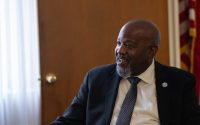Inflation Measure Favored by the Fed Cooled in August
Federal Reserve officials received more good news in their battle against rapid inflation on Friday, when a key inflation measure continued to slow, the latest evidence that a return to normal after the pandemic and higher interest rates are combining to wrestle rapid price increases back to a more normal pace.
The Personal Consumption Expenditures Index, which the central bank uses to define its 2 percent inflation goal, is still climbing rapidly on an overall basis. It rose 3.5 percent in August from the previous year, pushed up by higher gas prices, up slightly from 3.4 percent previously.
But after stripping out food and fuel costs, both of which are volatile, a “core” measure that Fed officials watch closely appeared much more benign. It picked up by 3.9 percent from a year earlier. Compared with the previous month, it climbed by 0.1 percent, a very muted pace.
It’s the latest encouraging sign for Fed policymakers, who have been raising interest rates since March 2022 in a campaign to slow the economy and cool price increases. While economic momentum has held up better than expected, a less ebullient housing market and a grinding return to normalcy in the car market have helped key prices — like automobile and rents — to fade. At the same time, supply chain disruptions that led to shortages and starkly pushed up prices starting in 2021 have gradually cleared up, allowing costs for many goods to stop rising or even come down slightly.
Given the progress, central bankers are now contemplating whether they need to raise interest rates further. They left them unchanged and in range of 5.25 to 5.5 percent at their meeting this month, while forecasting that they might make one more rate increase this year. At the same time, given how strong the economy remains, officials have signaled that they may need to leave interest rates set to a high level for longer to ensure that inflation returns to normal in a sustainable way.
“We’re taking advantage of the fact that we have moved quickly to move a little more carefully now,” Jerome H. Powell, the Fed’s chair, said during a news conference following the Fed’s meeting last week.
The question now is whether inflation can fade fully — getting back to something near the Fed’s 2 percent goal and staying there — without a bigger economic slowdown.
Multiple data points and anecdotes, from retail sales figures to some company earnings calls, have suggested that American consumers are managing to keep spending despite higher borrowing costs, which have made it more expensive to make big purchases on borrowed money.
Friday’s report showed that personal consumption expenditures climbed 0.4 percent in August from a month before, slightly softer than what economists had expected. Spending eked out a small increase after adjusting for inflation.
Historically, it has been difficult for the Fed to wrestle inflation lower without causing a big economic slowdown. Companies will generally raise prices if they can, so it requires slower demand to force them to stop. Fed policy is a blunt tool, so it is hard to calibrate it exactly.
But increasingly, central bankers have been signaling that they are hopeful they will be able to pull off a rare “soft landing,” cooling price increases without killing growth.
“At the end of the day, we will get inflation back to our target, whatever that takes,” Austan Goolsbee, the president of the Federal Reserve Bank of Chicago, said during a speech this week. “But we also can’t lose sight of the fact that the Fed has the chance to achieve something quite rare in the history of central banks: to defeat inflation without tanking the economy.”


